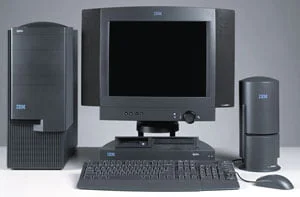
Revolutions are only revolutionary when they are new. Nowhere is this more true than in the e-business revolution. Five years ago few students were aware of the potential of e-business. Today, they might deal with a number of e-business enabled companies. They might buy books through amazon.com, find information about university life from studentnet.com or bank with an internet bank, such as smile. The e-business revolution has spread enormously into many aspects of young people’s lives.
IBM was the best known name in Information and Communications Technologies (ICT) in the 20th century. The IBM brand is all pervasive, and can be found on products as diverse as PCs, servers, software and high-end systems. It is also increasingly prevalent as the engine behind other companies’ branded products, or as the infrastructure behind websites all over the world.
Solutions
Its approach is firstly to develop e-business solutions and secondly to help businesses create the sort of customer relationship management platforms needed to build successful long-term relationships with its customers. Today almost anyone can create a website. However, in the competitive e-commerce world, the key differentiator is customer service. IBM is therefore sharing its experience in providing customer service platforms with other companies.
This case study examines how IBM, one of the world’s leading Information Technology and Communications businesses, is enabling a variety of other businesses to take the ‘e’ revolution further.

E-commerce is not a new phenomenon. Indeed, IBM is a long-established provider of communication networks. Organisations have been using these to exchange business data for many years. The exponential growth of the Internet has driven the accelerated expansion of this process. Until recently, e-commerce was concentrated on business-to-consumer activity (B2C) hence the explosion of .com companies. However, the development of the Web has made business-to-business (B2B) activity possible, leading to the development of a host of what are termed Internet exchanges.

By Spring 2000 the investing city’s and the public’s honeymoon with the .coms was over, as people realised that only a relatively small number of these companies would succeed in a competitive world. The real revolution was actually taking place in the old economy. Long-established companies like banks, insurance companies, car manufacturers and retailers were using e-business to develop new links with their customers.
Research carried out by IBM shows that Internet access in Europe will increasingly be via a range of devices and not limited to the PC. Mobile applications are becoming a major driver and enabler of e-business in Europe, which according to some observers is as much as two years ahead of the US on digital mobile technology. IBM customers in Europe are therefore seeking support in building the best possible links with their own customers drawing on IBM’s extensive experience in this field. The key question being asked by IBM’s business customers is: ‘How can we best communicate and meet the requirements of our customers, employees, vendors and suppliers using the latest e-business technology?’
IBM is providing the solutions in two phases:
- helping companies to create links to the Internet by creating the most appropriate systems
- building a new generation of e-business applications aimed at better customer relationship management, resource planning (ensuring supply meets demand through better monitoring of customer needs or preferences) and business intelligence (BI) which helps track customer performance.
The following case studies show how IBM has made e-business a working reality for many companies.
www.hmv.com

Through the Internet HMV can offer music to everybody 24 hours a day, seven days a week. The Internet is a very powerful delivery channel for music and books because it can offer a wide range of products to anyone without a very large high street presence. IBM provided HMV with an e-commerce presence based on a combination of:
IBM AS/400 platform – This integrates hardware, software, middleware and operating system to help run e-business – i.e. allows lots of people to order on-line at one time.
• Java – A tool to help ordering online.
• Websphere technology – Software that handles everything from catalogue and store front creation to security and payment processing.
While many of HMV’s UK high street stores offer a very wide range of music, the HMV Media Group wanted to offer customers the same selection, wherever they live. The solution was the development of an e-business website, which offers an extensive range of music, 24 hours a day, seven days a week. This solution also provides HMV with an excellent marketing tool to find out what customers are looking for. By analysing customer ordering on the Web, HMV can obtain a much clearer understanding of what the public is buying.
www.handelsbanken.com
Handelsbanken is the largest Scandinavian bank. Working with IBM it has developed systems for connecting customers to their bank account network through their mobile phones. The bank recognised its PC-based Internet banking service was rapidly becoming outmoded as customers sought to bank wherever and whenever they needed to do so. Research showed that Nordic countries have the highest use of mobile information devices in the world. This trend is also booming on a global scale with wireless subscriptions predicted to pass the one billion mark by 2003.
Handelsbanken chose IBM as its computing solution provider because it could supply hardware, software and the infrastructure to hold together the computing architecture. IBM’s experts devised a Wireless Application Protocol (WAP) solution – the industry standard for mobile Internet services – for Handelsbanken in under two months. It was integrated into the bank’s system in a record-breaking two weeks. These developments will give customers access to stock market data, account information and the ability to transfer money, buy goods and services, and pay bills simply by using their mobile phones.
Other examples of IBM solutions include:
- www.toycity.com – A Danish company website enabling customers to tour a virtual toyshop examining the merchandise and ordering toys from a wide range of famous brands.
- www.hazle.com – a specialist site outlining the ceramics of British artist Hazle Boyles Using the Web enables a talented individual like Hazle to sell her products in global markets including the lucrative US market. The site was created by IBM Business Partner, Quantum. Quantum specialises in offering affordable solutions to get small businesses onto the net using IBM technology. The site was built using HomePage Creator for e-business, a fully integrated solution that offers the tools a business needs to build an online store.

With a unique combination of hardware, software, services and experience, IBM is helping companies to improve Customer Relationship Management (CRM). Research carried out by IBM showed that European Chief Executives view “improving customer service” as one of their top business issues. This is why IBM has developed an integrated communications programme – e-customer service.
24 hours a day, seven days a week
With the Web revolution in full swing, an organisation’s customers are now expecting instant service. They are looking for up-to-the-minute account information, delivery status, product availability and trouble-shooting guides, 24 hours a day, seven days a week. With an IBM self-service website an organisation can revolutionise its customer service provision. Immediately, customers can answer their own simple queries, which in turn frees up an organisation’s staff to focus on core business activities.
By providing this level of service, customers avoid the frustration of busy phone lines, long queues and strict office hours. In 1999, IBM conducted over 28 million self-service transactions on the Web, saving over $800 million in support costs. IBM is helping British Airways change the way it does business. Via the Web, customers can check real-time arrivals and departures, book and pay for flights. Premium passengers can even choose their seat online. IBM has also helped BA to give its customer contact staff seamless access to a single customer record, thus allowing them to help customers on an individual basis.
IBM business intelligence software also enables organisations to analyse their customers’ needs. IBM did this for Jean-Paul Gaultier’s fashion site. This is more than just a virtual shop; it is a sophisticated market research tool. It spots which items sell better than others and suggests how to adjust the range for better profitability.
E-business is now an established way of organising business. It is no longer revolutionary. Organisations from the ‘new’ and the ‘old’ economy need to develop effective platforms to communicate through B2B and B2C links.
Today’s successful organisations are those who are not only creating the most suitable electronic links with customers, but are also providing the solutions that create optimal customer relationships. IBM has built up greater experience of this field than anyone else and is allocating many new resources to ensure that e-business is a success. Businesses know they can rely on IBM to help them forge a successful new future through e-business.
